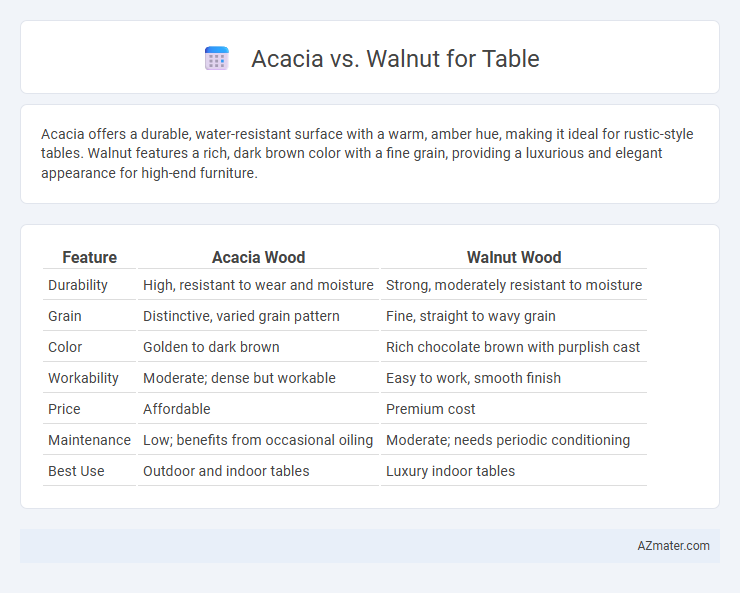Acacia offers a durable, water-resistant surface with a warm, amber hue, making it ideal for rustic-style tables. Walnut features a rich, dark brown color with a fine grain, providing a luxurious and elegant appearance for high-end furniture.
Table of Comparison
| Feature | Acacia Wood | Walnut Wood |
|---|---|---|
| Durability | High, resistant to wear and moisture | Strong, moderately resistant to moisture |
| Grain | Distinctive, varied grain pattern | Fine, straight to wavy grain |
| Color | Golden to dark brown | Rich chocolate brown with purplish cast |
| Workability | Moderate; dense but workable | Easy to work, smooth finish |
| Price | Affordable | Premium cost |
| Maintenance | Low; benefits from occasional oiling | Moderate; needs periodic conditioning |
| Best Use | Outdoor and indoor tables | Luxury indoor tables |
Introduction: Acacia vs Walnut for Tables
Acacia and walnut are two popular hardwood choices for tables, each offering distinct characteristics in durability, grain patterns, and color. Acacia wood is known for its rich, warm tones and natural resistance to water and scratches, making it ideal for everyday use. Walnut features a deep, chocolate-brown hue with a smooth grain, prized for its elegance and long-lasting strength in high-quality furniture.
Key Characteristics of Acacia Wood
Acacia wood is highly valued for its durability, natural resistance to moisture, and rich, warm tones that deepen over time, making it an ideal choice for tables in both indoor and outdoor settings. Its dense grain pattern provides excellent strength and scratch resistance compared to walnut, ensuring longevity in daily use. Acacia's eco-friendly properties and faster growth rate contribute to its appeal as a sustainable wood option for furniture manufacturing.
Key Characteristics of Walnut Wood
Walnut wood is prized for its rich, dark chocolate brown color with subtle purple undertones, making it a popular choice for high-end tables. Its dense and durable hardwood structure offers excellent resistance to wear and impacts, ensuring long-lasting furniture. Walnut also features a fine, straight grain with occasional waves, adding elegant texture and visual appeal to tabletops.
Durability and Hardness Comparison
Acacia wood exhibits high durability with a Janka hardness rating of approximately 1,700, making it resistant to scratches and dents for table surfaces. Walnut wood, though durable, has a lower Janka hardness of around 1,010, offering a softer feel that may show wear over time in high-traffic areas. Choosing acacia over walnut enhances table longevity and scratch resistance, ideal for daily use and maintaining aesthetic appeal.
Color and Grain Differences
Acacia wood showcases a rich variety of warm tones, ranging from golden browns to deep reddish hues, with a natural luster that enhances its striking, swirling grain patterns. Walnut features a darker, more uniform color palette, predominantly deep chocolate browns with occasional purple or gray undertones, highlighted by a smooth, straight grain interspersed with occasional waves or curls. The distinctive contrast between Acacia's vibrant, irregular grain and Walnut's refined, consistent texture influences aesthetic choices for tables, catering to both rustic and elegant interior designs.
Price and Value Considerations
Acacia wood tables generally offer a more affordable price point compared to walnut, making them a budget-friendly choice without sacrificing durability. Walnut tables, prized for their rich color and fine grain, command higher market prices due to their premium aesthetic and long-term value retention. Considering value, walnut's investment appeals to those seeking luxury and longevity, while acacia provides cost-effective versatility ideal for everyday use.
Sustainability and Environmental Impact
Acacia wood is highly sustainable due to its fast growth rate and ability to thrive in diverse climates, making it a renewable resource for tables. Walnut, while prized for its rich color and durability, grows slower and requires more intensive forest management, impacting its environmental footprint. Choosing acacia for tables reduces deforestation risks and supports eco-friendly practices by minimizing habitat disruption and promoting responsible harvesting.
Maintenance and Care Tips
Acacia tables require regular oiling with natural oils to maintain their rich color and prevent drying or cracking, while walnut tables benefit from periodic dusting and occasional application of furniture polish to preserve their smooth, dark finish. Both woods should be cleaned with a soft, damp cloth avoiding harsh chemicals that can damage the surface, and protective pads under hot or heavy items help prevent stains and dents. Proper humidity control is essential for walnut to avoid warping, whereas acacia's dense grain offers better resistance to moisture changes but still needs careful upkeep to sustain its durability and shine.
Best Uses for Each Wood Type
Acacia wood is highly durable and resistant to moisture, making it ideal for indoor and outdoor furniture such as dining tables and patio sets where longevity is essential. Walnut features a rich, dark grain that enhances luxury dining tables, desks, and bespoke furniture pieces, favored for its smooth finish and aesthetic appeal. Both woods are suitable for tabletops, but Acacia excels in high-traffic or outdoor environments, while Walnut is preferred for elegant, indoor settings requiring a refined look.
Which is Better: Acacia or Walnut for Your Table?
Acacia offers exceptional durability and resistance to water and scratches, making it ideal for high-use tables, while walnut is prized for its rich, dark color and elegant grain patterns that enhance aesthetic appeal. Walnut is generally softer and more prone to dents compared to acacia's dense hardwood properties, which sustain day-to-day wear and tear better. Choosing between acacia and walnut depends on prioritizing either robust longevity with natural rustic charm or refined luxury with a softer finish for a statement piece.

Infographic: Acacia vs Walnut for Table
 azmater.com
azmater.com